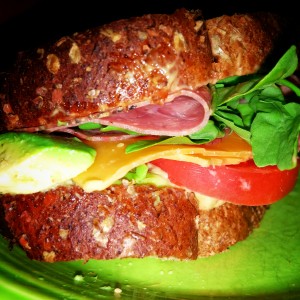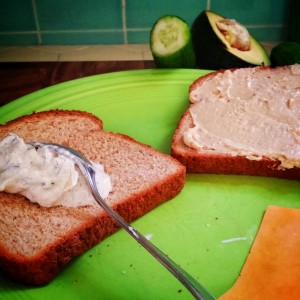To begin with, let us discuss the sandwich model by creating the model sandwich.

We get some insight from the WHO report about the populations that are most adversely affected by processed and red meat consumption. It has long been know that eating habits hold a lot of sway when it comes to healthy issues, cancer among them. And one of the most important places we see increases in disease is among the obese. There is a strong correlation between obesity and a high consumption of processed foods, including inexpensive meats such as hot dogs, lunch meat, salami, etc. What there is not a frequent correlation to, however, is an equal intake of vegetables and fruit, fresh or otherwise. Fiber plays a strong role in our digestive system, without which we are much more prone to a range of maladies. And fresh fruits and vegetables are nutritionally dense compared to processed foods, offering vitamins and minerals that are necessary for bodies to function properly, maintain good immune support and otherwise keep us in good health.
While this probably seems like basic common sense, significant percentages of the world population are malnourished or not eating a proper balance of fresh, whole foods. And here in the United States, it is very clear when a pile of processed meat is slapped between two slices of puffy white bread (with or without a slice of American processed cheese food and a dab of margarine), there is something lacking in a common lunch.
Simple Way To Make a Sandwich Healthier
One of the basic truths of an unhealthy diet is that it lacks enough color. Specifically, dark, vibrant vegetable color. When we are told to eat our greens, this is for good reason: green vegetables are nutritionally dense foods, meaning we get a lot of bang for our buck in terms of vitamins and minerals. When we look at a sandwich, it should be loaded with more than a stack of bologna.
It is easy to reduce the processed meat on a sandwich and make it more satisfying at the same time. While the protein from the meat may offer a nice, full feeling after consumption, this can also be achieved through the proper mix of ingredients (including some great sources of vegetable fat which will offer the same effect). Start by envisioning the sandwich as a salad on bread.
Americans frequently do not eat enough salad, especially greens. Maybe that thing known as potato salad, with its gobs of mayonnaise and starchy chunks, but we do not, in general, eat enough of the leafy stuff. Sandwiches, we consume by the droves. And a sandwich can hold pretty much anything we want to put on it.
Start with some hearty bread. While Wonder Bread may be soft and cuddly, it is also highly refined and falls apart easily. You don’t have to go into the land of crunchy seeds and ultra-dense loaves just yet, but pick a bread that your finger won’t stick through immediately when you poke it, or that won’t squish up in your hand like a little dough ball. Basically, you want some slices of bread that will hold up to being pressed together while clutching a pile of goodness between them.
 Skip the butter and skip the mustard or mayo. While those things are fine, super delicious even and certainly much better than margarine, you can use a spread like hummus or an aioli that offers some additional nutrition (even a good amount of protein in the hummus — as shown on this sandwich-in-progress, hummus on the right slice). Spreads are great, especially if the bread is a bit dry, but picking a healthier and heartier option immediately decreases the need for more meat. (The left slice pictured here has a dollop of tzatziki sauce, made from yogurt, vegetables and herbs.)
Skip the butter and skip the mustard or mayo. While those things are fine, super delicious even and certainly much better than margarine, you can use a spread like hummus or an aioli that offers some additional nutrition (even a good amount of protein in the hummus — as shown on this sandwich-in-progress, hummus on the right slice). Spreads are great, especially if the bread is a bit dry, but picking a healthier and heartier option immediately decreases the need for more meat. (The left slice pictured here has a dollop of tzatziki sauce, made from yogurt, vegetables and herbs.)
Cheese is great, too; but it is better in moderation. Certainly, nothing beats a great cheese sandwich if you are a cheese lover. But, like meat, too much cheese is often not the best idea and, by itself, is not the healthiest choice. Sliced thinly, it offers the same amount of flavor. And processed cheese food is not the same as cheese. It may have some calcium in it, but sticking with the natural version of cheese is probably the best idea most of the time.
But here is the good part. For a substantial sandwich that will not only get you through the afternoon, but will taste better than meat (or cheese) alone, there are quite a few healthy options for what you can slip between those slices of bread.
 Start with avocado. Not only is this nutritionally dense, but it has a lot of natural vegetable fat in it that will offer a feeling of satisfaction similar to meat. Because of the fat content, you won’t want to load up on it too much, but spreading a tablespoon or two on one side of the sandwich is a good place to start. Plus, the mushed avocado offers a way to hold some other vegetables in place.
Start with avocado. Not only is this nutritionally dense, but it has a lot of natural vegetable fat in it that will offer a feeling of satisfaction similar to meat. Because of the fat content, you won’t want to load up on it too much, but spreading a tablespoon or two on one side of the sandwich is a good place to start. Plus, the mushed avocado offers a way to hold some other vegetables in place.
Personally, I like to slice a jalapeno pepper and layer that over my avocado. Jalapeno peppers usually are not all that hot, in spite of their reputation — especially the really big ones. But if you don’t like the threat of heat, slice up a sweet bell pepper instead. Peppers come in all sorts of varieties and using them to get a few different colors involved, as well as a few other flavor options, is not only smart, but fun.
Be inventive with your toppings. Yes, you’ll want to include some lettuce, but try arugula instead of iceberg or romaine. If you can’t find that, throw on a handful of spinach or even shredded Brussels sprouts. Think out of the box, grate some carrots or zucchini, find whatever is available at the grocery store and see if there is some way to make it sandwich friendly (which only means it has to fit between those slices of bread in a way that won’t immediately fall out when you pick it up). Sure, onions and pickles are great starters, but expand your options and cram in the flavor.
Then, when it is piled high with sprouts or mushrooms or tomato slices or whatever you have on hand, go ahead and put on that slice of meat you so crave. After all, it’s delicious.
But the sandwich you have now is going to blow the old version away. And, loaded with the fiber and added nutrients from your fresh veggies, it is going to be a lot less of a cancer risk than the previous version of mostly processed meat.
Reduce the intake of processed meats while increasing the intake of fresh fruits and vegetables. It’s a simple solution to mitigate risk while encouraging a healthier lifestyle overall. If possible, it is a fantastic idea to get rid of nitrate/nitrite containing processed meats altogether (and that includes “uncured” lunchmeats, which are actually just as bad and sometimes even worse). Sandwiches are even better when the meat is freshly sliced from something freshly cooked right there at home. It isn’t always practical, but in the end it may even save you some money and help with a healthier lifestyle if you repurpose leftovers to make your lunches even more awesome.
Know someone who would appreciate the tips on a healthier sandwich? Please use the share buttons below! Thanks for reading!
One thought on “Worried That Your Sandwich Will Cause Cancer?”